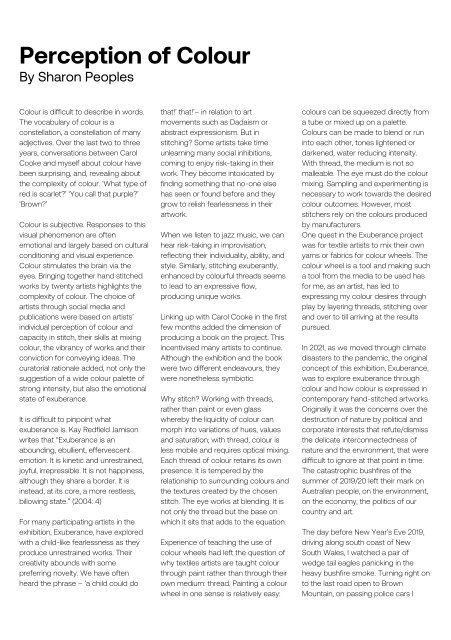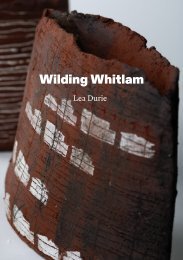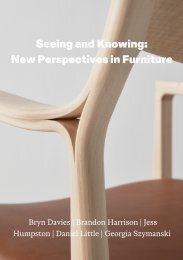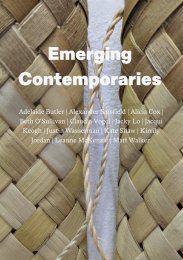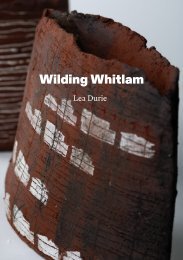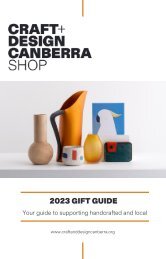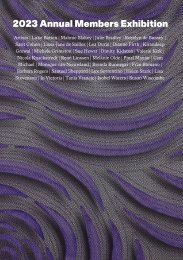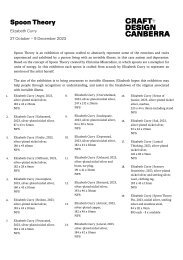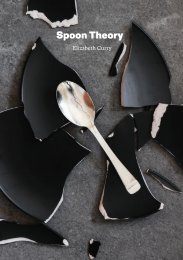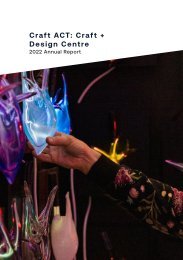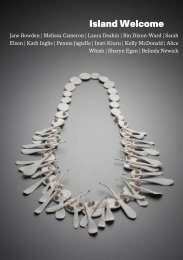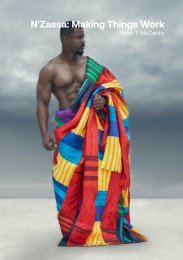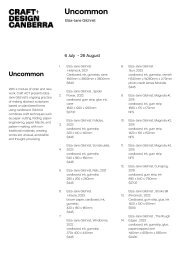Exuberance Exhibition Catalogue
You also want an ePaper? Increase the reach of your titles
YUMPU automatically turns print PDFs into web optimized ePapers that Google loves.
Perception of Colour<br />
By Sharon Peoples<br />
Colour is difficult to describe in words.<br />
The vocabulary of colour is a<br />
constellation, a constellation of many<br />
adjectives. Over the last two to three<br />
years, conversations between Carol<br />
Cooke and myself about colour have<br />
been surprising, and, revealing about<br />
the complexity of colour. ‘What type of<br />
red is scarlet?’ ‘You call that purple?’<br />
‘Brown?’<br />
Colour is subjective. Responses to this<br />
visual phenomenon are often<br />
emotional and largely based on cultural<br />
conditioning and visual experience.<br />
Colour stimulates the brain via the<br />
eyes. Bringing together hand stitched<br />
works by twenty artists highlights the<br />
complexity of colour. The choice of<br />
artists through social media and<br />
publications were based on artists’<br />
individual perception of colour and<br />
capacity in stitch, their skills at mixing<br />
colour, the vibrancy of works and their<br />
conviction for conveying ideas. The<br />
curatorial rationale added, not only the<br />
suggestion of a wide colour palette of<br />
strong intensity, but also the emotional<br />
state of exuberance.<br />
It is difficult to pinpoint what<br />
exuberance is. Kay Redfield Jamison<br />
writes that “<strong>Exuberance</strong> is an<br />
abounding, ebullient, effervescent<br />
emotion. It is kinetic and unrestrained,<br />
joyful, irrepressible. It is not happiness,<br />
although they share a border. It is<br />
instead, at its core, a more restless,<br />
billowing state.” (2004: 4)<br />
For many participating artists in the<br />
exhibition, <strong>Exuberance</strong>, have explored<br />
with a child-like fearlessness as they<br />
produce unrestrained works. Their<br />
creativity abounds with some<br />
preferring novelty. We have often<br />
heard the phrase – ‘a child could do<br />
that!’ that!’– in relation to art<br />
movements such as Dadaism or<br />
abstract expressionism. But in<br />
stitching? Some artists take time<br />
unlearning many social inhibitions,<br />
coming to enjoy risk-taking in their<br />
work. They become intoxicated by<br />
finding something that no-one else<br />
has seen or found before and they<br />
grow to relish fearlessness in their<br />
artwork.<br />
When we listen to jazz music, we can<br />
hear risk-taking in improvisation,<br />
reflecting their individuality, ability, and<br />
style. Similarly, stitching exuberantly,<br />
enhanced by colourful threads seems<br />
to lead to an expressive flow,<br />
producing unique works.<br />
Linking up with Carol Cooke in the first<br />
few months added the dimension of<br />
producing a book on the project. This<br />
incentivised many artists to continue.<br />
Although the exhibition and the book<br />
were two different endeavours, they<br />
were nonetheless symbiotic.<br />
Why stitch? Working with threads,<br />
rather than paint or even glass<br />
whereby the liquidity of colour can<br />
morph into variations of hues, values<br />
and saturation; with thread, colour is<br />
less mobile and requires optical mixing.<br />
Each thread of colour retains its own<br />
presence. It is tempered by the<br />
relationship to surrounding colours and<br />
the textures created by the chosen<br />
stitch. The eye works at blending. It is<br />
not only the thread but the base on<br />
which it sits that adds to the equation.<br />
Experience of teaching the use of<br />
colour wheels had left the question of<br />
why textiles artists are taught colour<br />
through paint rather than through their<br />
own medium: thread. Painting a colour<br />
wheel in one sense is relatively easy:<br />
colours can be squeezed directly from<br />
a tube or mixed up on a palette.<br />
Colours can be made to blend or run<br />
into each other, tones lightened or<br />
darkened, water reducing intensity.<br />
With thread, the medium is not so<br />
malleable. The eye must do the colour<br />
mixing. Sampling and experimenting is<br />
necessary to work towards the desired<br />
colour outcomes. However, most<br />
stitchers rely on the colours produced<br />
by manufacturers.<br />
One quest in the <strong>Exuberance</strong> project<br />
was for textile artists to mix their own<br />
yarns or fabrics for colour wheels. The<br />
colour wheel is a tool and making such<br />
a tool from the media to be used has<br />
for me, as an artist, has led to<br />
expressing my colour desires through<br />
play by layering threads, stitching over<br />
and over to till arriving at the results<br />
pursued.<br />
In 2021, as we moved through climate<br />
disasters to the pandemic, the original<br />
concept of this exhibition, <strong>Exuberance</strong>,<br />
was to explore exuberance through<br />
colour and how colour is expressed in<br />
contemporary hand-stitched artworks.<br />
Originally it was the concerns over the<br />
destruction of nature by political and<br />
corporate interests that refute/dismiss<br />
the delicate interconnectedness of<br />
nature and the environment, that were<br />
difficult to ignore at that point in time.<br />
The catastrophic bushfires of the<br />
summer of 2019/20 left their mark on<br />
Australian people, on the environment,<br />
on the economy, the politics of our<br />
country and art.<br />
The day before New Year’s Eve 2019,<br />
driving along south coast of New<br />
South Wales, I watched a pair of<br />
wedge tail eagles panicking in the<br />
heavy bushfire smoke. Turning right on<br />
to the last road open to Brown<br />
Mountain, on passing police cars I


